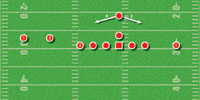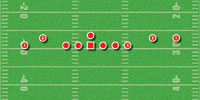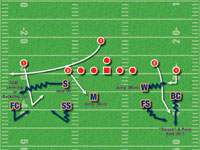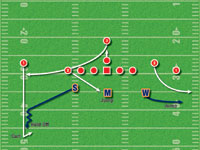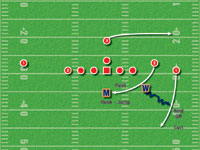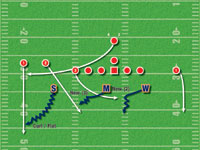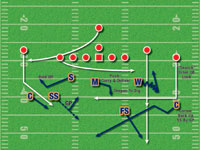AMERICAN FOOTBALL MONTHLY THE #1 RESOURCE FOR FOOTBALL COACHES
Article CategoriesAFM Magazine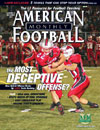
|
Match Up Zone Coverage vs. The Drop Back Passing Gameby: Tim HundleyUniversity of TX at El Paso © More from this issue Cover 4 coverage is our version of a match up zone defensive pass coverage. It is a zone taught through the concept of pattern reading specific receivers to determine what routes can aggressively be attacked and covered by linebackers as well as defensive backs. Pattern reading gives our linebackers and safeties the best chance to play all receivers in all routes and make adjustments for a particular game situation. Itís based on counting receivers from the outside to the middle of the formation (See Diagrams 1-A to 1-E). A certain receiver (usually #2 or #3) for the linebackers can be #3 or #4 in either trips or trey formations. They will determine how our eye progression will proceed and to which receiver our eyes go to as we pattern read from one receiver to another (See Diagram 2). This will enable linebackers to jump or attack certain routes, hold off and vision drop certain releases. They will be able to push and pass off other routes such as crossing routes (See Diagrams 3A to 3D).
Assignments: Will - 2 to 1 Eye progression - Jump Smash Mike - 3 to 2 Eye progression - Numbers of receivers change by receiver release or by their distribution. Mike jumps the new #3. Sam - 2 to 1 Eye progression - Keep leverage on the new #2 as receiver count changes by release but hold off the curl while you leverage #3. SS - #2 is off a straight line release - Set and transfer to QB. Cut to the #1 if QB takes you there. FC - MM #1. BC - call out smash and point - Cushion to the 7 route. FS - MM #2 from inside control Ė Expect corner help on the 7 route. These are the general rules for alignment and assignment and some basic techniques and keys for our position groups: Safeties: Our safeties align two yards inside or outside the #2 receiverís alignment based on the receiversí split. If #2 is tight (i.e., within three yards of the OT in alignment) we will line up in an outside advantage. If the receiver extends beyond that three yard alignment we begin to align inside advantage and control the receiversí release from inside out. Our depth is ten yards deep. Safeties are responsible for matching up on vertical release routes by #2 at a depth of ten yards. Routes that are under that depth are the linebackersí responsibility and allow the safetiesí to cut to other receiver routes based on route keying and the safetiesí ability to transfer their vision to the QB and look for work. Our initial key is the quarterback and we confirm our initial read with a line of scrimmage key which is usually the end two linemen on the LOS. We then transfer our eyes to the #2 receiver for our route key after weíve determined run or pass.
Corners: Our corners execute what we call a read man technique. This simply means we are man-to-man on the #1 receiver on all routes except crosser and smash routes (or China routes). We are at a depth of eight yards and are in an inside alignment on the WR. Based on WR splits, we will adjust to an outside alignment and control if the WR cuts his split. From this position we use a creep technique or slow pedal and train our eyes to read the QB through the three step; we then transfer our vision to the WR. If the WR runs a smash or shallow, we ask our corner to make a China call and point to the WR so we have a visual reminder that #1ís route will be released to the linebacker to cover. The corner then can zone their quarter looking for work. Generally with the smash route their work becomes the 7 route from the #2 receiver (Diagram 2). Outside Linebackers: The stress of this coverage is on the linebackers. Outside linebackers (Sam and Will) are responsible for defending the curl to flat and wheel routes. They match up to the widest threat ten yards deep and under on their side. They must always keep leverage on flat routes and act as a back stop to all perimeter routes not allowing any receiver to outflank them. To accomplish this the outside linebackers pattern read receivers. They pattern read the #2 receiver to #1 with awareness that the #3 receiver can always become the widest receiver. Vertical release by #2 must always be disrupted or rerouted. Any free release by #2 receiver puts tremendous pressure on our safeties. We use an open, shuffle, jam technique like basketball defenders use to reroute receivers. Our angle of departure to the receiver is slightly under a 45 degree angle. We keep our shoulders as parallel to the LOS as possible. Inside Linebackers: Our Mike linebacker determines his drop and coverage responsibility on the release of the #3 receiver. He is basically responsible for the middle hook to strong curl area (by release of #3). Based on that, our linebackers will know the distribution of the receivers and can begin to match up on a very aggressive zone concept to routes at or below ten yards and play those routes man-to-man to the completion of the play. These are the rules for our linebackers in the drop back passing game (See Diagrams 3A-3D): 1. Must be able to count receivers. 2. Must be able to pattern read receivers. 3. Must master eye progression A. Know when to jump routes. B. Know when to hold off routes C. Know when to push or deliver routes. 4. In learning and mastering these musts we will be able to defend the most difficult routes to this coverage; that is, those routes that involve crossers and delays. (See Diagram 4)
Cover 4 is a defensive coverage that can be adjusted to offensive route concepts. It can be game planned to lean towards a specific route based on pattern reading. This is the case in the 3 level middle concept where you can drive the strong safety to the post or the dig based on game plan or sideline adjustments. |
|
| HOME |
MAGAZINE |
SUBSCRIBE | ONLINE COLUMNISTS | COACHING VIDEOS |
Copyright 2024, AmericanFootballMonthly.com
All Rights Reserved



